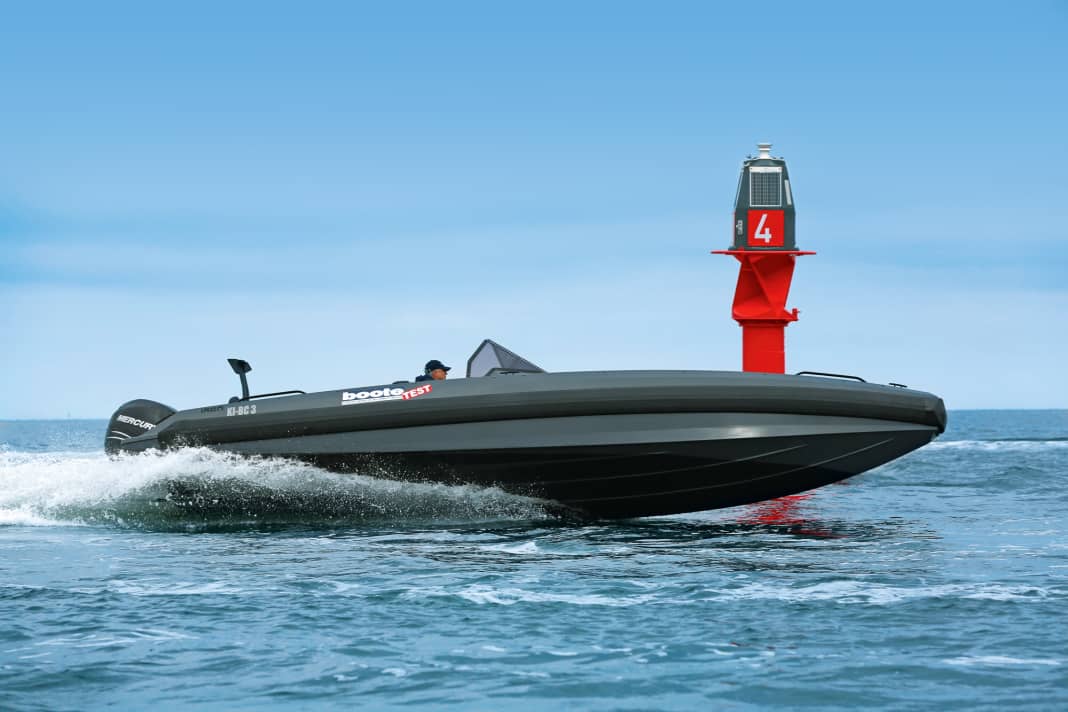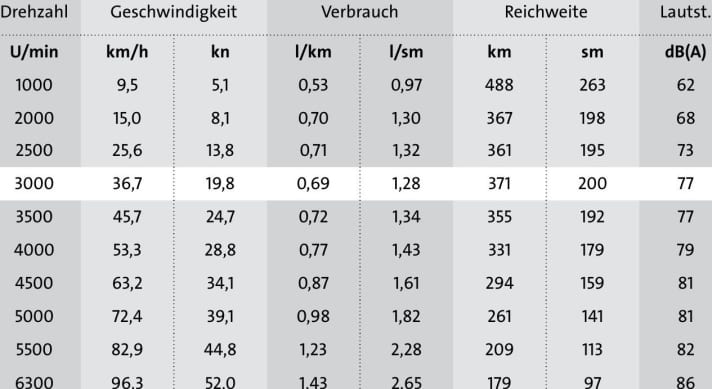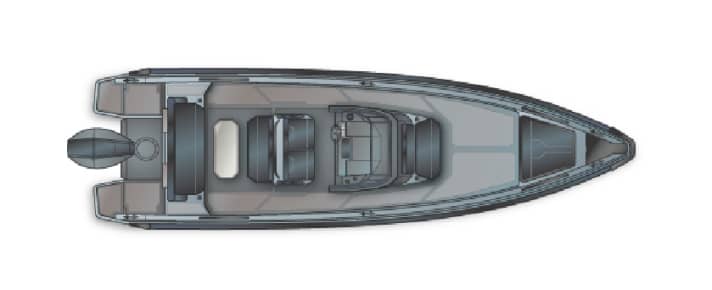





Anyone travelling on the Iron will feel that it is a driving machine from the very first few metres. Our employee Johannes Erdmann has already tested the Iron 767. In this issue, we take a closer look at the largest model, the Iron 827. She is moored in the Baltic Bay Marina in Laboe and we don't have far to go from there to the Olympic harbour in Schilksee, where another test boat, the Quicksilver Activ 605 is waiting for us. On the tour there, Tom Pagels (with Kevin Marquardt from the Kiel boat centre management) shows us the sporty performance of the Iron 827 and 400 hp Mercury combination after leaving the speed limit.
Later, when taking the measurements, we reach a maximum speed of 52.0 knots and I still feel safe and comfortable on the boat. In this situation, 2.65 litres per second run through the fuel line and the 302-litre tank is sufficient for just under 97 nautical miles plus 15% reserve. You can get more than twice as far with an economical sailing style, which is already reached at 3000 rpm at just under 20 knots. With 1000 rpm more, almost 30 knots are possible and a range of 178 nautical miles is calculated. All values that are quite respectable for this type of boat.

Iron 827 equipped with Active Trim
To ensure that the Iron sails in a comfortable trim position, an Active Trim is fitted to our test boat. It ensures that the power trim is controlled automatically and the driver does not have to worry about the trim knob. Not even when transitioning from displacement to planing. The bow lifts only moderately and the driver always has a clear forward view. This quick transition phase is also good for wakeboarders and the like. To hook them up, the shipyard installs a special mast at the stern.
When cornering fast with the outboard trimmed all the way to the transom, the hull pulls fully round and makes its tight circles without rocking. If the engine is trimmed, the hull reacts more sensitively to this action. Manoeuvres such as slalom manoeuvres and steering twists can also be performed safely and precisely at high speed. That leaves rough water sailing: as it was fairly calm, we only had a slight swell. So the waves from pilot boats and other commercial vessels had to be used and anyone who knows the stern seas from commercial vessels knows that they can be quite steep. However, these waves are no obstacle for the Test-Iron; the hull skips over them smoothly and dryly.
Now back to the harbour. The slow manoeuvres are just as easy to handle at the helm as the fast ones. If a harbour manoeuvre doesn't work out so well, no problem, because a thick, robust fender runs around the boat.
The technical equipment: The cables are all well laid and protected against chafing with sleeves at the passages on board. In terms of equipment, we are missing a hand bilge pump, otherwise we have found everything we need for safety on board. And the comfort? It's good with a fridge drawer, comfortable seats and a lounger.
Our test judgement
DRIVING & MANOEUVRING
+Sporty driving characteristics
+Well-organised driver's platform
PROCESSING & TECHNOLOGY
+High processing quality+Clean installationsSAFETY
+Professional fuel system
-No manual drain pump
COMFORT ON BOARD
+Firm upholstery
+Plenty of storage options
Conclusion from the test of the Iron 827
Despite its high speed, the Iron 827 always offers safe sailing characteristics. Ergo: the boat and 400 hp outboard engine are well matched. With the water ski mast, it makes a good towing boat and with the bathing platform, fixed seats and loungers, it invites you to swim and relax.
Technical data
The boat
- Shipyard: Iron Boats/SE
- Type: Iron 827
- CE category: C/9
- Hull and deck: Plastic
- Length over everything: 8,32 m
- Width: 2,44 m
- Depth: about 0.80 m
- Unladen weight (o.M.): 1450 kg
- Fuel tank: 302 l
- Freeboard (hedge entrance): 0,41 m
- Cockpit side height inside: 0,70 m
- Internal dimensions: 2.70 x 2.02 m (aft); 3.10 x 1.82 m (front)
- Sunbed foredeck: 2.72 x 0.90 m
- Max. motorisation: 313 kW (452 hp)
- Distribution: Bootscenter Kiel, Haßberg 6, 24113 Kiel, www.bootscenter-kiel.de
- Price (test boat): 97 950 €

The motor
- Manufacturer: Mercury
- Type: F400 Verado L6
- Performance: 294 kW (400 hp)
- Full load speed: 6200-6800 rpm
- Cylinder: 6 in series
- cubic capacity:2600 cc
- Fuel: Petrol
- Gear ratio: 1,75:1
- Test propeller: Enertia 3 x 14" x 19 "

